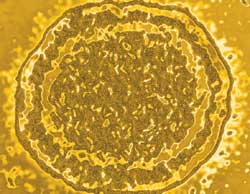Culture Wars: The Growing Mold Problem

Not too long ago, most people's idea of a bad mold situation was if they found a forgotten plastic container in the back of their refrigerator teeming with a black, fuzzy alien life form.
How simple such problems seem in hindsight. Now mold has mushroomed from its past status as a minor nuisance into a multibillion-dollar issue as a result of the increasingly harmful impact of the microbial culprit on residential and commercial buildings. In the past several years, mold damage in buildings has lead to an explosion in litigation; it is estimated that more than 10,000 mold-related lawsuits are currently pending throughout the United States.
Why has mold in buildings suddenly emerged as a crisis? The reason is the larger number of airtight buildings, which were designed that way partly in response to the energy crisis in the 1970s. In addition, a larger number of buildings throughout the country now have heating, ventilation and air conditioning (HVAC) systems, which all too often are poorly maintained and become fertile breeding grounds for mold. These two recent trends in building construction have been coupled with an greater awareness of the adverse health impacts of mold, especially through inhalation.
More than 200,000 species of mold have been identified worldwide with more than 1,000 species commonly found in North America. The three types of mold that are particularly gaining in notoriety are Stachybotrys chartarum, Aspergillus and Penicillium, the fungal Gang of Three. While molds themselves are fairly harmless, the mycotoxins (or secondary metabolites) they produce can have toxic effects on humans, such as fatigue, nausea, headaches and respiratory and eye irritations.
In our cover story "Breaking the Mold" that begins on page 22, author Hal Alper, president of Mycelx Technologies, provides an overview of the biological properties of mold, the human health impacts of this contaminant and techniques presently being used to remediate it in buildings.
Mold lawsuits are typically presented as construction defect claims by property owners, building owners and/or homeowner associations, including condominium associations. Mold is often named as part of the damages that result from the alleged construction defect where there is some form of water damage or moisture problem. The litigation is filed against general contractors, manufacturers, suppliers, installers and subcontractors. Almost any party who performed work in connection with the project in question can be named as a defendant.
To date, the causes of action asserted include breach of contract, failure to construct an adequate building for its intended purpose, breach of express warranty, breach of implied warranty and negligence. Typically, mold cases break down into several main categories, which include the following: negligent construction -- the builder breached his or her construction contract; negligent repair -- the landlord has a duty to maintain the premises and breached such duty; insurance bad faith -- the insurance carrier handled the claim improperly; and allegations related to a failed (HVAC) that promotes the growth of biological contaminants. Another cause of action that is gainer greater attention is the incorrect installation of exterior insulation finish systems, such as synthetic stucco or other similar products.
Currently, there is no federal law that sets strict standards for acceptable mold levels indoors. In March 2003, however, U.S. Representative John Conyers (D-Mich.) introduced the Toxic Mold Safety and Protection Act (H.R. 1268) in the U.S. House of Representatives. The "Melina Bill" is named after a seven-year-old Michigan girl whose family filed suit following the severe health problems the girl developed from mold exposure only three weeks after moving into a new home. The bill places responsibility on the shoulders of housing officials to make sure that residences are annually inspected and authorizes grants for the removal of mold in public buildings. Additionally, the bill asks the U.S. Environmental Protection Agency to ensure that state and federal government entities adopt federally regulated standards for mold inspection and remediation. It also has a provision for collection of damages by tenants and homebuyers who were not adequately informed of mold in their residences.
The passage of this legislation will probably jump-start a new cottage industry for environmental professionals who specialize in the inspection and remediation of buildings that contain microbial contaminants. Additionally, such professionals can work as expert witnesses in the mold litigation arena. The recent development of the new organization the National Association of Mold Professionals (NAMP) (www.moldpro.org) is a testament to the rapid growth of this emerging professional niche. The organization's certification is intended to prove that its members have achieved a high degree of knowledge, skill and proficiency in mold inspections and remediation. Along the same lines, other long-standing professional organizations are beginning to deal with mold issues. For example, the National Registry of Environmental Professionals (NREP) (www.nrep.org) has created a new Toxic Mold Committee that will review NREP's Toxic Mold Certification criteria, including educational requirements, work experience and examination categories.
With much of the environmental industry plateaued during these slow economic times, the booming work opportunities related to dealing with this serious health problem stand in welcome contrast.
This article originally appeared in the May 2003 issue of Environmental Protection, Vol. 14, No. 4.
This article originally appeared in the 05/01/2003 issue of Environmental Protection.